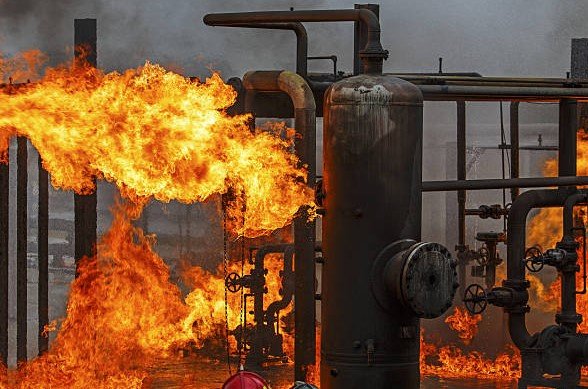One year after a massive chemical fire at the BioLab plant in Conyers, Georgia, residents continue to battle mysterious health issues tied to toxic smoke and debris. The blaze on September 29, 2024, released a plume of chlorine and other chemicals, forcing evacuations and shelter orders for thousands, and now sparks ongoing studies into long-term effects like persistent coughs and respiratory problems.
The Blaze That Shook Conyers
The fire started when a sprinkler malfunction mixed water with reactive chemicals at the BioLab facility, a maker of pool and spa products. Flames quickly spread, sending black smoke across metro Atlanta and prompting emergency responses from local and federal agencies.
Officials contained the initial blaze, but the chemical reaction lingered, creating a haze that affected air quality for weeks. Residents reported immediate symptoms such as burning eyes, throat irritation, and nausea. The incident marked the third major mishap at the plant in recent decades, raising questions about safety practices.
Evacuation orders covered a two-mile radius, displacing families and closing schools and businesses. Air monitoring showed elevated chlorine levels, though authorities assured the public that risks would fade quickly. Yet, many locals doubted those claims as symptoms persisted beyond the cleanup.

Persistent Symptoms Plague Residents
A year later, people in Conyers and nearby areas describe ongoing health struggles that disrupt daily life. From foster parents to business owners, stories highlight coughs that won’t quit, unexplained fatigue, and trips to doctors who struggle to connect the dots.
Virginia Crawford, a caregiver, evacuated with her foster son and returned to find both coughing nonstop. Another resident, Sandra Stephens Jordan, faced repeated hospital stays, searching for answers about her worsening condition. These accounts echo wider reports of nosebleeds, skin rashes, and even blood in mucus after exposure.
Experts note that mixed chemicals from the fire create complex toxins, making it hard to pinpoint causes. Short-term effects like eye and lung irritation were expected, but some face longer issues such as high blood pressure or memory fog.
Common symptoms reported by affected residents include:
- Chronic coughing and shortness of breath
- Headaches and dizziness that linger for months
- Skin irritations and unusual rashes
- Fatigue and sleep disturbances
Local clinics have seen a spike in respiratory cases, with some patients testing positive for chlorine exposure even now.
Communities worry about vulnerable groups, including children and the elderly. Pediatric emergency rooms noted more visits for breathing troubles in the months following the fire.
Investigations Uncover Safety Lapses
Federal probes by the Chemical Safety Board revealed troubling details about the incident. The plant stored twice the intended amount of reactive chemicals, contributing to the fire’s scale.
A pattern of negligence emerged, with past fires at BioLab sites pointing to repeated risks. County officials filed lawsuits against the company and its parent, seeking damages for health and economic harms.
Investigations continue, focusing on why safeguards failed. New updates show the fire grew more disturbing as facts surfaced, including improper storage and delayed responses.
| Key Timeline of BioLab Fire Events | Date | Details |
|---|---|---|
| Sprinkler Malfunction and Fire Start | September 29, 2024 | Water reacts with chemicals, igniting roof fire |
| Evacuation and Shelter Orders | September 29-30, 2024 | Thousands affected; toxic plume spreads |
| Initial Containment | October 2024 | Fire suppressed, but haze lingers |
| Plant Closure Announcement | May 2025 | BioLab ends manufacturing in Conyers |
| One-Year Anniversary Studies Launch | September 2025 | Health tracking begins for long-term effects |
This timeline shows how the crisis unfolded and why accountability remains a hot topic.
Residents demand the plant’s permanent shutdown, protesting a history of incidents that put lives at risk.
Broader Impacts on Community and Economy
The fire’s ripple effects hit local businesses hard, with some closing temporarily and others facing cleanup costs. Shopping plazas near the plant saw black smoke billowing overhead, scaring away customers for weeks.
Families like Crawford’s deal with emotional tolls, from disrupted routines to fears of future illnesses. Researchers warn that mixed exposures could link to serious conditions, though data gaps leave many in limbo.
Recent events, such as similar chemical incidents in other states, highlight a national need for stricter regulations. In Georgia, the BioLab case ties into broader talks about industrial safety near homes.
Economic losses include medical bills and lost wages, with lawsuits piling up from those claiming health damages. One resident shared how the fire changed everything, from daily habits to long-term plans.
New Studies Aim to Uncover Truths
A three-year study launched in early 2025 tracks health effects across six metro counties, focusing on chlorine exposure and beyond. Led by public health experts, it reviews data from water, soot, and air samples collected post-fire.
Researchers like Dr. Ziad Kazzi discuss irritant effects, while others like Dr. Beatrice Golomb explore links to chronic issues. This work addresses why single-chemical tests often miss the full picture in real-world disasters.
The Agency for Toxic Substances and Disease Registry started a public health evaluation, analyzing contaminant levels. Findings could shape future guidance and compensation for victims.
As probes wrap up, Conyers pushes for better monitoring and corporate responsibility. Emerging data suggests some symptoms may become permanent without early intervention.
Path Forward Amid Uncertainty
With BioLab closing its Conyers manufacturing in 2025, relief mixes with ongoing worries. Residents seek clear answers on risks, from cancer potentials to environmental cleanup.
Experts urge documenting symptoms and pushing for comprehensive care. The story underscores how deregulation can endanger communities, echoing disasters like East Palestine.
Share your thoughts on this ongoing issue or similar experiences in the comments below, and spread the word to raise awareness about chemical safety.
